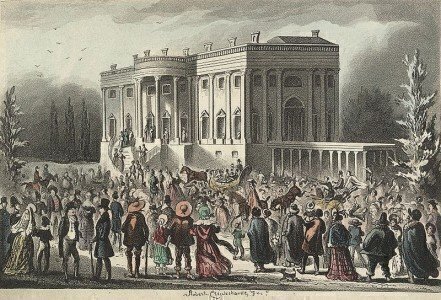As Constitution Daily counts down to Inauguration Day, we look back at three presidential ceremonies from the 1800s that ended very badly.

Usually when historians recount the pomp and circumstances of swearing in a new president, it’s the stirring speeches, the dramatic balls, and the swelling parades that are recounted.
But like any large public event, there’s always a potential for problems, and back in the 19th century, there were times when chaos and calamity had a place on Inauguration Day, too.
For example, there were constant rumors that Abraham Lincoln would be killed at his 1861 inauguration. The rumors were taken seriously: Lincoln took a special overnight train from Baltimore as a matter of security. In the aftermath, the media questioned Lincoln’s courage.
Four years later, the Lincoln team had to deal with another public relations problem: His new vice president, Andrew Johnson, apparently showed up drunk for his own speech. There were theories why Johnson appeared to inebriated, including claims he was ill and had used alcohol as part of a recommended treatment.
These incidents, however, paled in comparison to three really, really bad situations that developed at inaugurations in 1829, 1841, and 1857, which left the White House ransacked by a mob, one president dead, and another 36 people as victims of a fatal disease (including three congressmen).
The first famous incident was the inauguration of President Andrew Jackson in 1829 after his bitter campaign against John Quincy Adams.
Jackson was the first president to take his oath outside at the Capitol in Washington. A huge crowd for the time period, at least 20,000 people, waited for the new president.
What happened next is truly legendary. The crowd migrated to an open house at the White House, as part of another tradition that lasted until the time of President Grover Cleveland.
The crowd quickly turned into a rowdy, drunken mob that smashed objects inside the White House. Jackson escaped either through an open window or side door, and organizers put large amounts of free booze on the White House lawn to lure the mob out of the building.
To make matters worse, an open feud broke out at the inaugural ball when the wives of Jackson’s cabinet members shunned a fellow wife, as part of what was later called the Petticoat Affair.
The most famous infamous inauguration gone wrong is that of President William Henry Harrison, who was literally killed by his own speech in 1841.
Harrison, 68, decided to give a two-hour speech, in very cold, wet weather, without wearing a coat or a hat. The crowd was reportedly not thrilled by the speech, during which he spent a lot of time talking about ancient Rome.
The new president then attended a parade and three inaugural balls, possibly in the same wet clothing he wore outside during the speech. He also drank at the inaugural balls.
Within a month, Harrison was dead from pneumonia and pleurisy. While there’s a debate about what exactly killed Harrison, the inauguration was linked to his death.
One theory is that Harrison caught a cold that developed into pneumonia, while another is that the president had pre-existing conditions that were aggravated by his outdoor antics.
But the most tragic of inauguration horror stories happened in 1857, at James Buchanan’s ill-fated inauguration.
Buchanan’s fate was linked to an episode in 1857 called the National Hotel disease, an outbreak of an illness tied to pre- and post-inauguration activities that left at least 36 people dead.
In an eerie resemblance to the Legionnaires’ disease outbreak in Philadelphia a century later, guests who attended events at one of Washington’s biggest hotels came down with a mystery illness, and then died quickly or over the course of the following two years.
Buchanan himself contracted the disease twice and survived: once before his inauguration and once shortly after it. In both cases, he was at the hotel.
Among the 36 fatalities were people who attended the official post-inauguration banquet at the hotel, including three U.S. congressmen.
Rumors spread that Buchanan had also died, but he recovered after spending the first weeks of his presidency in bed.
Today, experts believe inadequate sanitary conditions existed in the hotel, including problems with its sewage system. It was mostly people who ate at the hotel who became ill, while bar patrons showed no symptoms.
The hotel was demolished in the 1920s and now a tourist attraction, the Newseum, sits on its location.







